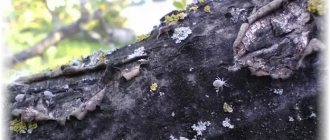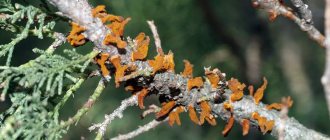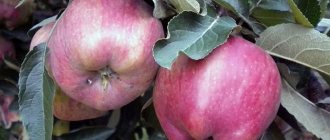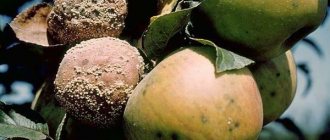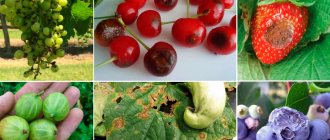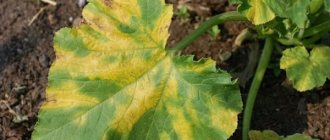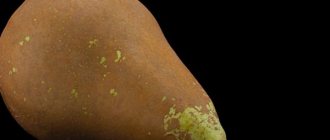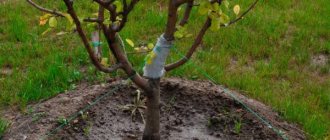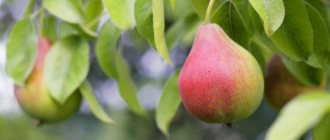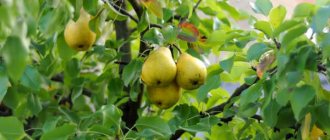Trees in the garden get sick often, and the main difficulty for you is to make an accurate diagnosis in order to take appropriate measures.
Pear leaves can turn yellow, curl, and become covered with plaque in early spring; fungi, viruses, and bacteria also infect the bark, fruits, and branches. From this review you will learn about the main diseases of pear trees, their symptoms, signs and methods of treatment. This will allow you to detect the problem at an early stage and take appropriate measures.
Fungi and infections most often affect plants within the same group and also spread between them. Therefore, preventive and therapeutic treatments of pears, apple trees, plums and stone fruit trees are recommended to be carried out simultaneously.
Diseases
Pear diseases are caused by viruses, bacteria and fungi. Those diseases that are caused by fungi manifest themselves in the form of plaque, rot, and spots. Pathogens spread with water, wind, and can be carried by insects.
Bacterial lesions appear as black, rotten, oily spots that subsequently cause certain parts of the plant to die.
Both bacteria and fungi can persist for a long time on plant debris and in soils, so it is important to promptly clean gardens and burn leaves and rotten fruits.
Viral diseases are transmitted with the sap of a diseased crop through garden tools and insects. The main symptoms are ring spotting, mosaic, and death of individual plant parts.
In sick pears, the yield decreases and the quality of the fruit deteriorates. For this reason, treatment is mandatory.
Let's look at the main diseases:
- Scab is caused by Fusicladium pirinum. The leaves are affected, olive-colored spots with a velvety coating form on them, the fruits begin to rot, and their peel cracks. If young fruits are affected, they become deformed and pears grow asymmetrical.
- Fruit rot is caused by the fungus Monilia fructigena. The disease manifests itself as brown spots; over time, growths form that contain fungal spores. The wind can carry these spores throughout the garden and, accordingly, infect other crops. The pulp loses its taste and becomes loose.
- Sooty fungus - appears on the leaves in the form of a black coating similar to soot. The disease is caused by a fungal culture that especially loves weak plants suffering from a lack of microelements and nutrients. Over time, the soot fungus spreads to the fruit.
- Powdery mildew - its development is provoked by the Erysiphales parasite. The disease is easily detected by visual inspection, as it manifests itself as a characteristic white powdery coating. Affected inflorescences and leaves dry out and fall to the ground. Young crops are most susceptible to powdery mildew.
- Rust is caused by Pucciniaceae microorganisms. First, light yellow, and then orange, rather dark spots form. The fruits must be disposed of.
- Brown spot - the first signs of the disease appear during flowering, when olive spots appear on the upper side of the lower leaves. Then they turn yellow, become covered with plaque, and fungal spores begin to infect neighboring plants and leaves. Over time, all the green parts dry out.
- Mosaic disease - manifests itself in the form of white and green spots on fruits and leaves.
Red dots on pear leaves are usually a harbinger of rust, but there are other reasons - this article will tell you how to deal with them.
Mosaic disease spots can have different shapes and sizes; over time, the leaves change their original contours. Infected seedlings grow slowly and develop poorly, and wither away over time.
Violation of the rules of care is the third reason why the leaves on the pear turn black
At times it seems that the leaves on the pear have turned black. Upon closer examination, the reason appears to be a lack of care.
Violation of the watering schedule
Pear leaves seem to turn black after a long period of heat, because dust accumulates on them. Moreover, this phenomenon occurs even in those trees that receive enough moisture through irrigation. Trees in the south are especially susceptible to this. The problem can be easily resolved by sprinkling.
Nutritional deficiencies
It happens that the leaves on a pear seem to turn black due to lack of nutrition. In areas with acidic soil, the crown takes on a dark yellow tint. Due to a lack of calcium, the edge of the plate darkens first, then the top. The leaves will not turn black if, when watering, you fertilize the pear once every 7-10 days with calcium nitrate.
A lack of boron is easily determined, causing young seedlings to become deformed, leaves to dry out and curl. A characteristic feature is the formation of rosettes of leaves at the tops of the branches. Eliminate the problem by spraying the pear with a solution of boric acid.
The leaves turn black as a result of a lack of phosphorus - the color is dull, with a bronze tint, with red-violet shades near the petioles and veins. Flowering and fruit ripening are delayed. Pears are treated by feeding with superphosphate.
Diseases of the bark and trunk
Lesions of the bark and roots are more difficult to detect than diseases of the leaves and fruits. Main pear pathologies:
- Black pear cancer - the disease affects the bark of the skeletal branches and trunk, which over time becomes covered with cracks that quickly increase in size. Gradually, the bark is completely torn, the cambium is exposed. Along the edges of the cracks there are brown spots - open wounds that often become wet.
- Cytosporosis is a stem rot. The bark in the affected areas turns red-brown and dries. The disease develops as a result of frost damage and sunburn.
- Fire blight is one of the most dangerous diseases of pears, which causes blackening of the leaves. The first signs of infection appear during flowering - the inflorescences quickly begin to fade and acquire a brown tint, the leaves turn black and curl, but do not fall to the ground, the bark and shoots die off.
- Root cancer affects all fruit crops, affecting the root system - roots, root neck. The disease likes to form growths of different shapes and sizes - usually soft and gray-white, up to 12 cm in diameter, over time they become dark and hard. Over time, the plants die.
The bark affected by Cytoporosis, as in the case of black cancer, is recommended to be cut off and covered with clay.
Most pear diseases are very persistent. Therefore, complex treatments and destruction of all affected parts of the tree are needed.
Pests are the second reason why pear leaves and ovaries turn black
From a distance, it sometimes seems that the tips of the young shoots and leaves of the pear are turning black. But often this is not a manifestation of the disease, but the multiplied insects, as a result of their vital activity, transform the tree. When there are large numbers of pests, insecticides are used.
Medyanitsa
A small insect sucks the juice from the leaves and green shoots, causing the pear leaves to turn black and curl. After the larvae of the honeydew, sticky secretions remain on the leaf blades. The internal parts of buds, buds, and young leaves are also glued together. Often after copperhead, the leaves turn black due to the development of sooty fungi or scab. Insects are fought with folk remedies - infusions of onion peels, garlic, tansy, to which wood ash is added.
Aphid
Multiplying colonies of small black insects live on young shoots and suck the juice from the greens. Over time, the leaves and young shoots curl and turn black. Aphids are fought with folk remedies, solutions of soap, soda, and treated with insecticides.
Gall mite
Tree pests overwinter in buds, up to 1500 individuals in one. The length of the tick is only 0.18 mm. There, before exiting, females lay 5 eggs. Mite larvae feed on the juice of leaves that have not yet blossomed. Then galls form on the plates - small yellow-brown swellings that later turn black. The leaves weaken and the process of photosynthesis stops.
Fertilizer application activates processes in the leaves, making it difficult for mites to feed. Acaricides used:
- Akarin;
- Omite;
- Nissan;
- Flumite;
- Apollo;
- Neoron.
Pests
Various pests also cause great harm to pears. Let's look at them:
- Gall mite - actively spreads in windy weather, feeding on the sap of tree leaves. First, when affected, brown spots form on the surface of the foliage, then the green parts of the crop begin to turn black and fall off. All this negatively affects the development of the crop and the ripening of fruits. The gall mite loves trees with affected branches that are not removed in a timely manner, thickened plantings, and crops deficient in mineral nutrients.
- Hawthorn - butterfly caterpillars eat the foliage, causing the tree to become weak and die. The only way to combat it is to remove the affected branches and treat other parts of the tree and other garden crops.
- Pear copperhead - causes gradual deformation of the stems and, ultimately, the death of the tree.
- Aphids pose a serious threat to pear orchards. She chooses the most delicious and juicy places - buds, inflorescences, young shoots, the lower part of the leaves. Aphids suck plant juices, which leads to disruption of photosynthesis processes, curling of leaves, and slower growth of trees. If measures are not taken in time, the pear may die.
- The flower beetle gnaws round holes in the buds and buds. Females lay eggs in closed buds, from which larvae then emerge and eat different parts of the flower. In general, the flower beetle has an extremely negative effect on the condition of the tree in general and its productivity in particular. Both therapeutic and preventive measures are equally important. This parasite may be the reason why the pear does not bear fruit.
In addition to the listed insects, the pear is also affected by the leaf roller. How to deal with leaf roller is described here.
Pests pose a danger not only to pears, but also to other garden crops. Therefore, carefully monitor the condition of the plantings and take action if necessary.
Parasites
Very often the pear tree is attacked by pests. If you don’t start fighting them in time, not only the crop will die, but also the plant itself.
hawthorn
This attractive insect is a butterfly that can in a short time rid a tree not only of all the greenery and flowers, but also of the ovaries, leaving the branches bare. The pest usually attacks the plant in late autumn. The manifestation is the presence of twisted dry leaves covered with cobwebs - hawthorn caterpillars build huts for the winter.
Insecticides used to treat the tree and regular digging of the soil will help get rid of pests. If you are unable to prevent the moths from appearing, collect them by hand from the weeds where they roost.
Gray aphid
Gray aphids are considered one of the most dangerous pests - they live almost everywhere, harm vegetation, feeding on its juices, which is why the plant does not receive proper nutrition. This leads to a slowdown in development and growth, and eventually the tree withers and dies. Overgrown colonies of aphids pose a great danger - they can completely cover the branches. When shoots and branches are infected by aphids, a sticky coating forms on them. Ants are carriers of aphids.
To destroy aphids, in early spring, spray the plant with mineral oil preparations or a mixture of kerosene and diesel fuel - this prevents the appearance of caterpillars from eggs. Apply insecticide treatments between the time new larvae emerge and before the winged females emerge.
Sapwood
Sapwood is a dangerous pest that can cause irreparable harm to a farm. The larvae and beetles feed on the bark of the trunk and large branches and can also infect healthy specimens. Sapwood larvae live in the bark of plants and make many tunnels in it.
In the spring, when the pear blossoms, pupation occurs. Pathogenic microorganisms, fungi and bacteria enter the plant through the holes, causing secondary diseases to develop. The beetles gnaw out areas in the forks of branches and around the buds. Buds and young shoots die.
For prevention, keep the area clean, cut off dry and damaged branches, then burn them. Apply organic and mineral fertilizers in a timely manner, whiten the trunks and bases of skeletal shoots. Use chemical insecticides to kill the pest. Carry out two treatments during the growing season: after flowering and after 2 weeks. For treatment, it is recommended to use the following drugs: Aktara, Mospilan, Confidor, Vector.
Pear flower beetle
The pear flower beetle is a weevil with a gray-brown body. The pest eats the leaves. Lays eggs in the first half of autumn, the first larvae appear in early April and gnaw out the buds from the inside. This leads to the fact that the plant does not bloom, which is why fruiting stops.
To combat the pest, follow these steps: destroy the larvae by tearing off damaged buds (dryish, with a brown tint). Spread a cloth or plastic film under the tree and carefully shake off the adults from the plant. Use chemicals: organophosphates, insecticides. Gardeners also recommend pesticides of biological origin (Aktellik, Tanrek, Akarin, Fufanon).
Apple scale
Scale insect larvae attach to the tree trunk and suck sap from the bark. This occurs throughout the spring and summer period. This leads to a slowdown in the development of the pear, the death of branches and young shoots.
Get rid of scale insects in the spring: clean the bark from the old dead layer using a metal brush, moistening it in a solution of wood ash and tar soap (200 g and 50 g per bucket of water). Before the buds open, treat the tree with organophosphorus insecticides: Phosfamide or Actellik.
Apple flower beetle
This is a small brown beetle that causes damage to pear buds. In autumn, the pest lays eggs in the buds of the plant. The flower beetle overwinters inside the buds and begins to eat them out in the spring. This leads to the buds not blooming.
To combat the flower beetle, shake off the beetles onto a cloth laid under the tree. Carry out the procedure during the swelling and opening of the buds, at a temperature of no more than +10 degrees, so that the pests do not fly away. Pour the collected insects with a solution of water and kerosene.
Pear moth
The pear moth is dangerous because it feeds on fruits. In summer, the pest lays eggs on the fruits; the hatched larvae penetrate the fruits and eat the seeds. Early varieties and soft-skinned pears are especially susceptible to attack.
To combat the pear moth, use not only conventional insecticides, but also biological pesticides. No less effective is digging up the soil, removing damaged fruits, and removing weeds.
leaf roller
The leaf roller is a vicious pest that attacks all parts of the tree. When the bark is damaged, the growth and development of the tree is slowed down, resulting in reduced productivity.
To damage and protect the pear from the leaf roller, in the spring, remove dead bark, treat the trunks with lime, and treat the plant using mineral oils and organophosphorus complexes.
Apple moth
Apple moth is a small moth that causes great harm to the plant. The larvae feed on the pulp of leaves and fruits, which is why they die.
If round white mines are visible on the leaves, immediately begin to combat the pest. First, spray the trees with a solution of laundry soap and hot pepper. If this method does not work, use insecticides.
Pear psyllid
The psyllid is dangerous because it slowly kills the plant. The pest is capable of sucking out all the juice from the foliage, causing the plant to be deprived of nutrients, which leads to slower growth and development, decreased yield, and weakness. Over time, copper dew appears - a breeding ground for sooty fungus.
For prevention, clean trees of dead bark, lichens and moss. To combat, use insecticides and traditional methods: treating the plant with tobacco smoke, a solution of ash and soap, and silicate glue.
Very often, pears are exposed to various diseases and pests. If you know how the disease manifests itself, what symptoms indicate its presence, you will be able to start the fight in a timely manner and save the pear from death. Pests are also controlled in effective ways to help prevent yield loss.
1
0
Copy link
Prevention measures
The main measure for maintaining the health of pear trees and obtaining a stable harvest is not the treatment of diseases, but their prevention. The sooner you take action, the better the consequences will be. Basic treatments for pears in spring against pests:
- timely cleaning, complete destruction of fallen leaves;
- thinning overly thickened crowns;
- regular spraying with copper oxychloride (0.3%), Bordeaux mixture (1%), colloidal sulfur (1%);
- planting resistant varieties;
- tillage around the trunk.
Any disease is not a death sentence for a pear, but the sooner you take action, the better. Be sure to regularly inspect your plantings for the presence of characteristic disease symptoms and take immediate action. Remember that most pear diseases are dangerous for all fruit trees, so by wasting time, you risk the health of the garden.
Spraying
In the spring, pears are treated with Bordeaux mixture 1% - directly during bud break or after flowering. In autumn, all affected fruits and leaves are destroyed, and doubtful shoots are removed.
Additionally, treatments with a urea solution at a concentration of 7% are indicated; the use of fungicides Tarcel, Delan, Topsin M, Skor, Fundazol, Bayleton is allowed.
Whenever possible, choose varieties that are resistant to the most common diseases in your region.
Tillage
Use only healthy seedlings for planting; after pruning diseased crops, treat with tools; promptly remove dead leaves and old leaves. The main measure of soil cultivation is its deep loosening around the trunk.
It is also recommended to whitewash the bark, timely treatment of damage and frost damage. Since many diseases love weakened trees, apply a sufficient amount of mineral fertilizers in the spring and other fertilizers.
Scab
Scab is one of the most common fungal diseases. The disease manifests itself as dark spots on the surface of leaves, young shoots and fruits. If the problem is ignored it can lead to the death of the tree.
Fighting methods
Shoots infected with scab must be pruned and destroyed.
To combat scab, the tree is sprayed with the following preparations. In this case, the best effect is achieved by alternating them:
- copper sulfate;
- Bordeaux mixture;
- copper oxychloride;
- colloidal sulfur.
Pear processing is performed five times per season. Spraying is carried out at the following time intervals:
- kidney formation;
- bud formation;
- completion of flowering;
- two weeks after flowering;
- at the beginning of autumn.
The first manifestations of scab.
conclusions
- All diseases of pears are divided into several categories - infectious, bacterial, viral. They pose a serious threat to plantings, over time lead to the death of trees, reduce yields in the current season or lead to their complete absence.
- Diseases of foliage and bark are much easier to detect than diseases of roots. Inspect the plantings regularly, paying attention to even the slightest suspicious moments.
- In addition to diseases, pears can be affected by pests. The main ones are aphids, hawthorn, copperhead, flower beetle, gall mite. Over time, small insects completely destroy the tree, spread to other garden crops and harm them.
- The best protection against pests and diseases is preventive treatment. They are made in the spring. It is also recommended to mulch the soil and apply mineral fertilizers according to the calendar.
- There are varieties that are more and less resistant to pests - August dew, Pamyati Yakovlev, Veles, etc.
Also read - what to do if the bark of a pear is cracked.
Presence of aphids, mites, leaf rollers
Pear infestation by pests leads to nutrient deficiency, darkening and curling of the foliage. The tree's immunity weakens and it becomes susceptible to disease.
How to fight
To get rid of parasites, it is necessary to treat with herbicides. Decis and Intavir are also effective drugs for controlling insects. After the fruits have formed, treatment with an onion-garlic solution gives a good effect.
Mites on a pear.
Signs of scab on a tree
Rust on a pear: how to treat it
When a tree stops producing fruit, it is difficult to immediately understand what is wrong. At the same time, experienced gardeners know that the absence of an ovary and its instability, weak flowering are signs of a tree being infected with scab. Examining a pear leaf, you can see that it begins to turn black from the bottom, and gradually the hearth will acquire a dark, dull color. As a result, the foliage will fall off and the plant will remain naked ahead of time.
Important! Unhindered propagation of the disease subsequently leads to a deterioration or complete cessation of the fruiting process. The infection affects bud formation and crop formation.
If the fungus infection occurs after the fruit has set, the infection will spread to the fruit. As the fruit develops, the fungus grows and a dark brown dot appears, velvety to the touch. Before the fruit ripens, the spots are round and small in diameter. The more the fruits ripen, the darker the fungus becomes on them. An infected pear can change shape and become gnarled.
Scab can form not only on foliage and fruits. The appearance of cracks and swelling of the bark on the shoot is one of the symptoms of the development of fungal spores inside. When the swelling bursts, the spores spread to the rest of the tree, continuing to cause damage. The infected part of the tree becomes covered with small, almost imperceptible cracks, which then begin to peel off.
Fruit rot: characteristic signs
Fruit rot
The orchard is the best buffet for this disease. Here you have both an apple tree and a pear tree... This disease affects all stone fruit plants. Which parts of the tree are most affected by fruit rot?
The disease immediately appears on the fruits in the form of brownish-brown spots. Then pillows with a gray tint appear, consisting of spores and mycelium. The latter, in turn, are arranged in concentric circles. The fruit itself not only changes color on the outside, but also on the inside. The fact is that the pear pulp turns brown.
If you place the affected fruit in storage, the fungus will soon cause black rot. What will happen to the fruit? The front part of the pear may become black with a shiny tint, and the inside of the fruit will become dark brown.
Fruit rot should be treated in the same ways as other fungal diseases, namely, comprehensively. Pears affected by the disease should be constantly collected and burned. Remove mummified fruits from trees that have survived the winter on a branch.
Let's not forget about processing. The tree should be sprayed, thereby protecting it from the invasion of not only diseases, but also pests, such as weevils, moth caterpillars or others. The main responsibility of the gardener is to protect the plant as much as possible, including from mechanical damage during the harvesting process. You need to remove the fruits carefully, carefully, without harming the branches and bark of the crop.
Substances used against scab are suitable as chemical treatments. If you want your pear harvest to be well preserved until next spring, check each fruit for damage or stains. After all, a fruit infected with fruit rot and placed in storage can destroy the entire harvest.
